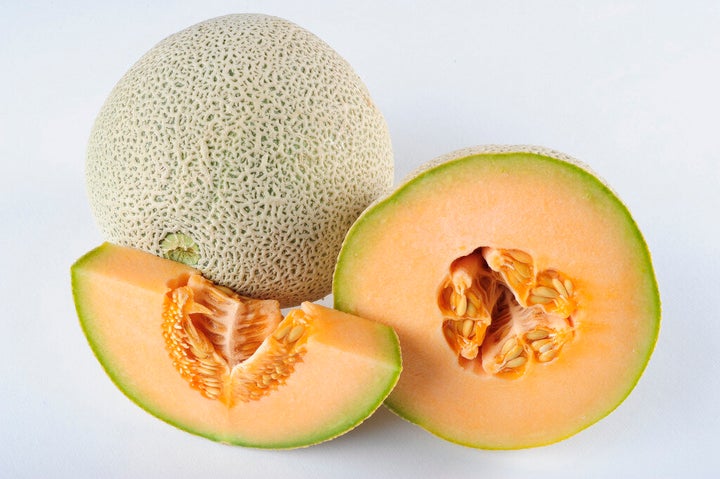
Numerous reports of salmonella and listeria-contaminated cantaloupes have poured in over the last few months and years, leaving us scratching our heads. Why do cantaloupes seem more likely than other fruits and vegetables to carry pathogens?
A Food Safety News article from September of 2011 confirms our observation: cantaloups have been responsible for at least 36 outbreaks since 1990.
Roy Costa, president of Environ Health Associates and a registered sanitarian, told Food Safety News that the cantaloupe's unique, rough skin can trap and hold bacteria, which can easily penetrate to the inside of the melon.
Additionally, while bacteria doesn't usually grow on the surface of most fruits and vegetables after harvest due to lack of moisture and nutrients, according to the FDA, bacteria has been found to grow on the outside of cantaloupe and watermelon after being picked. And there are several points of contamination along the supply chain -- growing, harvesting, packing, storage, transport, distribution and processing -- all the way to the consumer's kitchen, where simply cutting the melon can transfer pathogens to the edible parts of the fruit.
Contaminated irrigation water could also be a culprit, especially considering melons sit on the ground and could soak in infected water indefinitely:
Animals can affect the crop directly or through contamination of the water supply used for irrigation and crop protection. Manure may contain animal wastes, and fertilizers pose their own unique threat.
FDA guidelines from 2009, which note melon-associated outbreaks accounted for 507 illnesses and two deaths between 1996 to 2008, offer more explanations. One sounds strikingly similar to the well-known supermarket trick of making a cut at the base of the melon and taking a whiff to see if its ripe:
Cantaloupe harvest is usually based on the melon stage of maturity as judged by the formation of an abscission zone between the vine and the melon. This characteristic of cantaloupe maturity is commonly called "slip," and most melons are harvested between 3/4 and full slip. Cantaloupe stem scars may provide a potential route for entry of human pathogens to the edible flesh of melons. As melons mature and ripen, they have a greater propensity to allow for the survival and multiplication of human pathogens on their surface
The guidelines also note that melons may be turned multiple times during their maturation to develop properly, which can mean more opportunities to spread pathogens. Melons are also heavy, which may make them more susceptible to machine damage during handling.
The potential reasons go on and on. The high sugar content may also be to blame -- it can attract insects, which themselves can spread pathogens.
In the last few months alone, several significant cantaloupe contaminations have grabbed headlines. In September of 2011, health officials said that a Listeria outbreak associated with cantaloupe was the worst outbreak in more than a decade. Up to 16 people died across 18 states. Those melons were traced to a farm in Colorado.
In July, a North Carolina farm recalled 580 crates of cantaloupes that had been shipped to New York, citing a potential Listeria contamination. The farm later recalled its entire growing season's worth of cantaloupes and honeydew melons, which had been distributed across Florida, Georgia, Illinois, Kentucky, Massachusetts, Maryland, Maine, Michigan, North Carolina, New Hampshire, New Jersey, New York, Ohio, Pennsylvania, South Carolina, Virginia, Vermont and West Virginia.
A more recent outbreak has been traced to Indiana's Chamberlain Farms, with 178 reported cases of salmonella poisoning across numerous states. Nationwide, 60 people were hospitalized and two people died in Kentucky.
The U.S. isn't the only country have experienced outbreaks associated with cantaloupe. In 2006, a rise in cases led Australia's New South Wales state -- which calls cantaloupes "rockmelons" -- to issue warning with helpful suggestions as to how consumers can reduce their chances of infection:
- Do not purchase melons that are bruised or damaged. If buying fresh cut produce, ensure it is refrigerated or surrounded by ice.
- Fresh produce should be refrigerated within two hours of peeling or cutting. Leftover cut produce should be discarded if left at room temperature for more than two hours.
- Wash all rockmelons with cool tap water immediately before eating. Don't use soap or detergents. Scrub melons with a clean produce brush. Cut away any bruised or damaged areas before eating.
- Wash hands often. Hands should be washed with hot soapy water before and after handling fresh rockmelons. Wash surfaces often. Cutting boards, dishes, utensils, and counter tops should always be washed with hot soapy water and cleaned after coming in contact with fresh produce, or raw meat, poultry, or seafood.
- Don't cross-contaminate. Use clean cutting boards and utensils when handling fresh produce. If possible, use one clean cutting board for fresh produce and a separate one for raw meat, poultry, and seafood.
Consumers should do their best to investigate where their cantaloupes are coming from and stay abreast of current recalls. In the even that a cantaloupe label is missing, the CDC has a simple piece of advice: "When in doubt, throw it out."
Photo by Flickr user mrsdkrebs.
Correction: A sentence in this article originally said that FDA guidelines noted that melons "have to be" turned multiple times during their maturation, while the guidelines instead noted that melons "may be hand turned multiple times" during their growing season. The sentence has been amended to reflect this.
